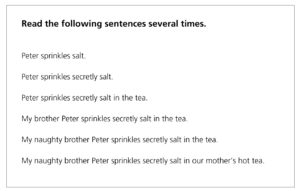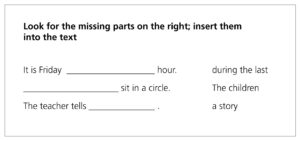Procedure:
The goal of an increasingly fluent identification and interpretation of particularly frequent clauses in the first language can be approached with various exercises. Examples:
- From a dwarf sentence to a giant sentence (see exercise a below) can be best accomplished with long paper strips.
- Completing sentences (see exercise b below).
- Commbining clauses: the teacher distributes sheets of paper for this exercise. The pages are divided by a line down the middle. On the left side are the sentence beginnings, and on the right side, the second half of these sentences, but in a different order. The students must draw lines to correctly combine the beginnings and the ends of the sentences that belong together. (Example: In the summer, I swim → happily in the sea).
Remarks:
- Many of these exercises lend themselves well for working in pairs.
- Many of the worksheets for these kind of exercises can be prepared by the older students for the younger ones.
- It is certainly possible to conduct these exercises with older students as well, particularly if they still experience difficulties in dealing with clauses in their first language.
Exercise a)

Exercise b)







